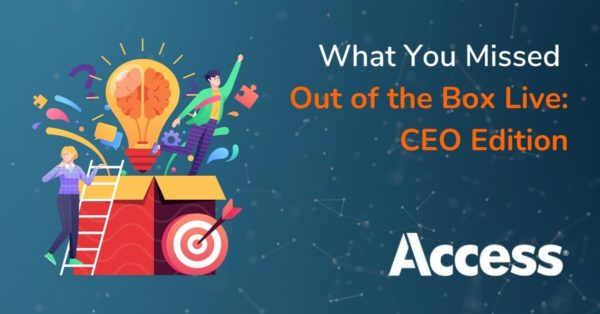
If you’re not familiar with Out of the Box Live, it is Access’ regular web series about records management, information governance and digital transformation.
We focus on how our industry can best leverage technology to ensure that your essential assets are secure but easily retrieved by the right people at the right time.
Our latest episode, which featured Access’ CEO Ken Davis, and CTO Matt Hillery, focused on a timely topic that I elaborate on a bit more in this blog. The show provided an excellent opportunity to hear from two leaders at the head of a fast-growing and innovative business that protects critical information for millions of people in the most highly regulated and document-centric industries in the world. I don’t know if you were able to join us, but no matter – you can now check out the replay on-demand.
We covered a lot of ground and offered many insights into the way Access is aligning with the needs of its clients to navigate the paradigm shift happening in Information Management due to today’s remote/hybrid work environments.
Here are some of the highlights:
We learned a bit more about Access CEO Ken Davis
Ken was a scientist in a prior life. While he was originally an atomic physicist and knows his way around an electron or two, he eventually decided that the science life wasn’t for him.
Ken told us in retrospect that he enjoyed “working with a lot of great people on interesting problems. But after a lot of time working in a room with no windows, I just didn’t see myself doing that for another 20 or 30 years.”
His next role was in consulting with IT companies, and his background in science landed him with the consulting firm McKinsey for a bit, and then with Gartner thereafter where he spent nearly 17 years continuing his work leading teams and advising organizations on IT-related topics.
One thing we can confirm – he’s happy that his home office has plenty of windows!
The client must be the focus
At Access, we’ve never been quiet about the fact that understanding client’s needs should be the first and last thing you think about every day.
Everything falls into place when you do that.
As your client navigates the world, their needs are their North Star, so as a service-based organization, Access’ clients’ needs are our needs.
Conversations with clients and keeping them in your immediate focus gives fantastic insights into how you can help them navigate change.
Virtualizing the physical world enables efficiency
One of the great ways of imagining the world of records management was shared by Ken.
In short, Ken described three tiers of records:
- First-tier: Records kept close to your person (e.g. in a briefcase or home office)
- Second-tier: Records kept in an onsite records room
- Third-tier: Records stored in a records center
The events of the past two years have complicated the question of how to handle each of the three tiers.
The first and third tiers were fairly squared away but it was the second, middle tier of records that has been the greatest point of frustration for many of Access’ clients during this pandemic.
There are solutions, however, like Access Unify which can make that physical file room into a “virtual” one that can allow your records to be securely accessed no matter where your employees happen to be working that day, anywhere in the world.
There will be a continual paradigm shift of the office
One of the key points of our conversation surrounded the shift in how organizations leverage their physical space.
As Ken noted, “most companies’ path returning to the office is not likely to match the path exiting the office. My impression is that most companies are being cautious in coming back and when we do come back, it will be 2 to 3 days per week with some tech companies going [fully remote-first].”
There’s a good reason for that:
Companies can enjoy immense savings by shedding 50% of their square footage due to shifting to either a remote-first or hybrid model.
This won’t happen all at once though. Most corporate leases are for 7 to 10 years. So, as their leases come up for expirations, organizations are going to have to have a conversation about how much space they really need, want, or use which means this trend is likely to be a decade-long one.
I can personally confirm this trend has more than just begun.
After walking around doing a recent onsite visit with a client, there were literally a handful of people. There were, of course, office services people keeping the ship running, but it was a veritable skeleton crew except in the corner office.
There was a person there, surrounded by stacks of paper stationed on either side of him. For him, it was business as usual.
But he was absolutely the exception.
Changes
The world changed in 2020 and the information management world continues to change.
Many information management programs experienced the evolution, going from the convenience of keeping semi-active files in an onsite records room, to suddenly dealing with the inconvenience of having all those necessary records in an unreachable place.
What we can confirm is this: The normal we’re in now and the normal six months from now is going to be different than the normal we had first going into the pandemic.
For more guidance on how to optimize a remote or hybrid information management program, be sure to check out this episode’s Out of the Box Live replay.



